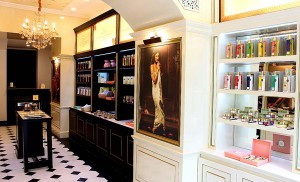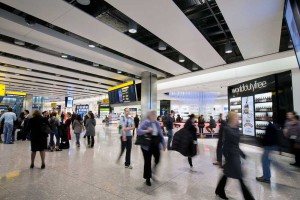T2, Mumbai’s swanky new, art-suffused international terminal at the Chhatrapati Shivaji Maharaj airport is rapidly becoming the new hub for luxury brands.
In the last few months, beauty and fashion luxury brands like Forest Essentials, Kimaya, Amrapali and Michael Kors have opened shop at this modern airport. Tarang Arora, Creative Director and CEO of the brand, says, “With the increase in travel and tourism in and out of India, shopping at the airport is gaining momentum as one of the hottest trends for luxury brands. We’re glad to be hopping onto the bandwagon and are certain will be able to appeal to the aesthetics of both Indian as well as international airport shoppers. An already international name, this store will bring us one step closer to strengthening our brand recall across the globe as India’s finest jewellery destination.” The new terminal is estimated to serve about 40 million passengers each year, a captive audience for luxury brands who are obviously looking at finding customers at airports across the world.
Much like Mumbai’s T2, Delhi’s 3 or the Indira Gandhi International Airport in Delhi has evolved into a lucrative location for several luxury brands. “Our ticket size at airport is double in value compared locations elsewhere,” says Ruchita Sharma, marketing operation manager of high-end crystal products maker Swarovski’s consumer goods business. The brand store at the T3 terminal of the Delhi airport ranks among its top stores by sales globally.
The trend is a reflection of the global luxury retail trend.

At the Heathrow Airport’s Terminal 5, for instance, Christian Dior’s dove grey carpets and boudoir mirrors vie for customer attention along with Prada’s harlequin tiles. The polished hardware of Dolce and Gabbana handbags glint not far from lustrous exotic-skinned accessories by Gucci. At Terminal 5, passengers reportedly buy over $450 million per year of perfumes, clothing, scarves, sunglasses, jewellery, watches, bags and small leather goods from brands like Alexander McQueen, Burberry and Chanel, the airport’s top performer.
A similar scene plays out each day at plethora of major international airports across the world, from Singapore’s Changi and South Korea’s Incheon to Dubai International and Charles de Gaulle in Paris.
The biggest draw for brands is the premium customer profile of international passengers. Today, marketing remains a key reason to invest in airport real estate, but the volumes are so good that retailing at airports is not just about marketing your brand anymore. Airports, in fact, are transforming into fantastic pieces of real estate.

London Heathrow Airport, England
At the Heathrow airport a survey by Generation Research, a Stockholm-based consultancy reveals that duty-free and travel retail sales of perfumes, cosmetics and luxury goods jumped 28 percent in the last two years and will be worth $120 billion per year.
For brands, airports are great destinations to not just sell luxury but also monitor the profile of their buyers, especially young affluent customers who may be buying a brand for the first time. This information is often used to create marketing strategies targeted at this younger, newer group of buyers.
Many luxury brands, particularly in India, are surprised by the volume of sales. Kimaya, a high-end fashion house for instance did not expect hurried travellers to buy couture when it first opened its outlet in Delhi’s T3. Its promoter Pradeep Hirani says he had turned down an offer to open a shop at the airport two times before saying yes the third time. “For us, it was more about exhibiting our collection than selling it.” But he was surprised that Kimaya’s airport store sales are much higher than its high street outlets. Hirani regrets having opted for a revenue-sharing model, where the retailer pays a percentage of its sales as rental to the airport operator, instead of the high rentals the airport had quoted earlier. What makes airports in India such exciting options is the sheer size of the space available. T3, for instance, is the fourth largest retail hub in India.
Clearly, airport shopping has come a long way from the time when all you could buy was kitschy souvenir of the country you were visiting.


